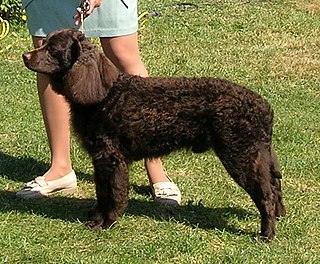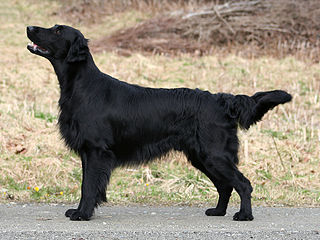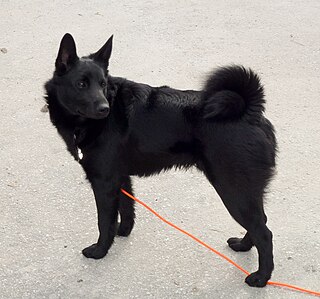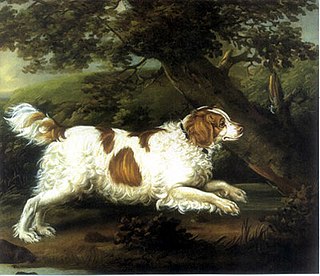
The Labrador Retriever or simply Labrador is a British breed of retriever gun dog. It was developed in the United Kingdom from St. John's water dogs imported from the colony of Newfoundland, and was named after the Labrador region of that colony. It is among the most commonly kept dogs in several countries, particularly in the European world.

The American Water Spaniel is a breed of spaniel which originated in the United States. It was developed in the state of Wisconsin during the 19th century from a number of other breeds, including the Irish and English Water Spaniels. The breed was saved by Dr. Fred J. Pfeifer, who set up the breed club and standard, and whose work led to recognition for the breed by the United Kennel Club, and later, the American Kennel Club. While they are the state dog of Wisconsin, they remain a rare breed.

The Barbet is a medium-sized breed of French water dog. It is a rare breed. The breed's name comes from the French word barbe, meaning 'beard'.

The Flat-coated Retriever is a gun dog breed originating from England. It was developed as a retriever both on land and in the water.

A retriever is a type of gun dog that retrieves game for a hunter. Generally gun dogs are divided into three major classifications: retrievers, flushing spaniels, and pointing breeds. Retrievers were bred primarily to retrieve birds or other prey and return them to the hunter without damage; retrievers are distinguished in that nonslip retrieval is their primary function. As a result, retriever breeds are bred for soft mouths and a great willingness to please, learn, and obey. A soft mouth refers to the willingness of the dog to carry game in its mouth without biting into it. "Hard mouth" is a serious fault in a hunting dog and is very difficult to correct. A hard-mouthed dog renders game unpresentable or at worst inedible.

Cocker Spaniels are dogs belonging to two breeds of the spaniel dog type: the American Cocker Spaniel and the English Cocker Spaniel, both of which are commonly called simply Cocker Spaniel in their countries of origin. In the early 20th century, Cocker Spaniels also included small hunting spaniels.

The Goldendoodle is a designer dog created by crossbreeding a Golden Retriever and a Poodle. First widely bred in the 1990s, they are bred in three different sizes—each corresponding to the size of Poodle used as a parent.

The German Wirehaired Pointer is a medium to large-sized griffon type breed of dog developed in the 19th century in Germany for versatile hunting. It became a leading gun dog in Germany in the later part of the 20th century. It is the result of the careful mixing and crossing of the Wirehaired Pointing Griffon, German Shorthaired Pointer, German Roughhaired Pointer, and the hunting Pudelpointer in the late 19th century.

Gun dogs or bird dogs are types of hunting dogs developed to assist hunters in finding and retrieving game, typically various fowls that are shot down on the flight. The term hunting dog is broad and includes all breeds and skills of hunting canines, but "gun dogs" refers to canines that are trained to work alongside a loud firearm while hunting or retrieving game. Gun dogs are divided into three main categories: pointers and retrievers, setters and spaniels, and water dogs.

The English Cocker Spaniel is a breed of gun dog. It is noteworthy for producing one of the most varied numbers of pups in a litter among all dog breeds. The English Cocker Spaniel is an active, good-natured, sporting dog standing well up at the withers and compactly built. There are "field" or "working" cockers and "house" cockers. It is one of several varieties of spaniel and is the foundation of its American cousin, the American Cocker Spaniel. The English Cocker is closer to the working-dog form of the Field Spaniel and the English Springer Spaniel. English Cocker Spaniels are also known as the "Merry Spaniel" due to their constantly wagging tail.

The Portuguese Water Dog originated from the Algarve region of Portugal. From there the breed expanded to all around Portugal's coast, where they were taught to herd fish into fishermen's nets, retrieve lost tackle or broken nets, and act as couriers from ship to ship, or ship to shore. Portuguese Water Dogs rode in fishing trawlers as they worked their way from the Atlantic waters of Portugal to the waters off the coast of Iceland fishing for cod.

The Nova Scotia Duck Tolling Retriever is a medium-sized gundog bred primarily for hunting. It is often referred to as a "toller". It is the smallest of the retrievers, and is often mistaken for a small Golden Retriever. Tollers are intelligent, eager to please, alert, and energetic. The name "toller" is derived from their ability to lure waterfowl within gunshot range. The breed originated in Yarmouth County, Nova Scotia, Canada. The American Kennel Club ranks the toller as the 87th most popular dog breed.

The Irish Water Spaniel is a breed of dog that is considered tall by spaniel standards.

The Small Münsterländer is a versatile hunting-pointing-retrieving dog breed that reached its current form in the area around Münster, Germany. The Large Münsterländer is from the same area, but was developed from different breeding stock and is not related as the names would suggest. Small Münsterländers bear a resemblance to both spaniels and setters but are more versatile while hunting on land and water. The Small Münsterländer is recognized by the Fédération Cynologique Internationale under Group 7, Section 1.2, Continental Pointing Dogs of Spaniel type, by the American Kennel Club as a Foundation Stock Service breed, and by The Kennel Club and the United Kennel Club as a gun dog. It is related to the Epagneul Français and the Drentsche Patrijshond.

The Stabyhoun, or Stabijhoun or Stabij, is one of the rarest dog breeds in the world. It hails from the Dutch province of Friesland; its origins lie in the forested region of eastern and southeastern Friesland. The breed has been mentioned in Dutch literature dating back to the early 1800s, but it was not until the 1960s that the breed became known outside its native province; the first Stabyhouns left the Netherlands some decades later, in the 2000s. The name Stabijhoun translates roughly to "stand by [me] dog". The dog is considered a Dutch national treasure. Today, there are only a few thousand Stabyhouns worldwide.

The Boykin Spaniel is a medium-sized breed of dog, a Spaniel bred for hunting wild turkeys and ducks in the Wateree River Swamp of South Carolina, in the United States. It is the state dog of South Carolina, where it was discovered and further developed by hunters in the early through mid 1900s. September 1 is Boykin Spaniel Day in South Carolina, originally established in 1984.

The Black Norwegian Elkhound is a small Spitz breed classified by the FCI as a hunting dog. It is currently an uncommon breed in Norway and very rare outside the Nordic countries of Scandinavia. It is a sibling breed to a Grey Norwegian Elkhound, but is smaller, more agile, doesn't bark and was bred explicitly for on-leash dog hunting.

The Wetterhoun is a breed traditionally used as a hunting dog for small game and waterfowl and native to the province of Friesland in the Netherlands. The name of the breed comes from the West Frisian Wetterhûn, meaning "water dog." The plural of Wetterhoun is Wetterhounen in Frisian. The breed may also be called the Otterhoun or Dutch Spaniel, although it is not a Spaniel-type dog.

The English Water Spaniel is a breed of dog that has been extinct since the first part of the 20th century, with the last specimen seen in the 1930s. It was best known for its use in hunting waterfowl and for being able to dive as well as a duck. It is described as similar to a Collie or to a cross between a Poodle and a Springer Spaniel with curly fur and typically in a white and liver/tan pattern.

The Golden Retriever is a Scottish breed of retriever dog of medium size. It is characterised by a gentle and affectionate nature and a striking golden coat. It is a working dog, and registration is subject to successful completion of a working trial. It is commonly kept as a pet and is among the most frequently registered breeds in several Western countries; some may compete in dog shows or obedience trials, or work as a guide dog.




















